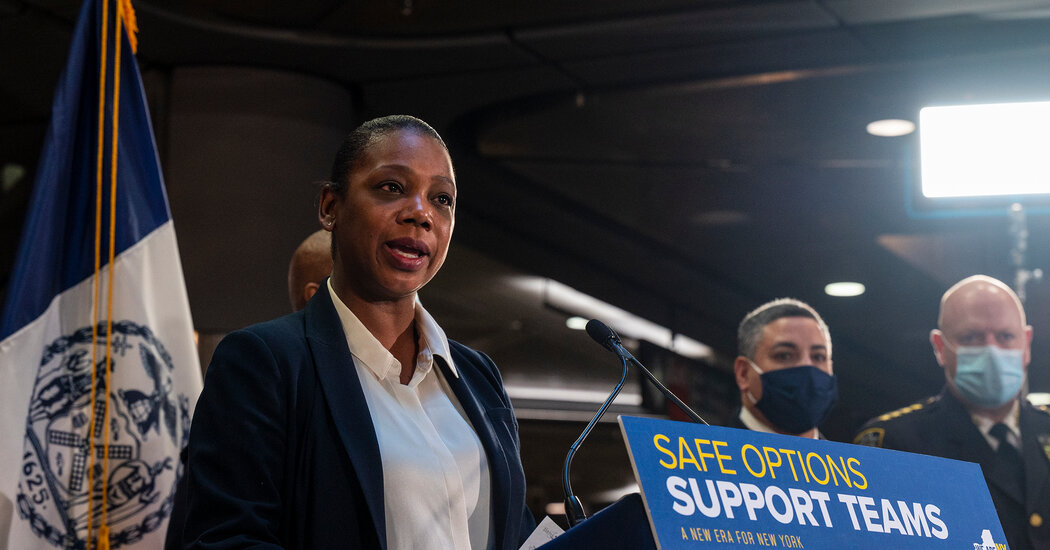Keechant Sewell, who took over the New York Police Department as an outsider, was immediately faced with a series of shocking crimes.
Detective Felicia Richards did not expect to cry. But during an emotional eulogy just over an hour into the second of two funerals for police officers shot to death last month in Harlem, tears began to run down her face.
Standing at the pulpit in St. Patrick’s Cathedral was Keechant Sewell, who had been the commissioner of the New York Police Department for one month and one day. And for the second time, she was paying tribute to an officer who had been killed in the line of duty. The seven-minute eulogy mixed warm recollections of Detective Wilbert Mora’s life and aspirations with expressions of grief shared in his relatives’ native Spanish.
For Commissioner Sewell, the first woman to lead the largest police force in the nation, the remarks at the funerals of Detectives Mora and his partner, Jason Rivera, carried the weight of longstanding tradition. And for at least some in the pews, her performance began to answer questions about her readiness for the job: Ms. Sewell was plucked from a comparatively obscure position in the Nassau County Police Department by Mayor Eric Adams.
“If there was anybody who was on the fence, she got them that day,” said Detective Richards, the president of the Guardians Association, a fraternal organization of Black police officers. “It wasn’t about what else was going on, it wasn’t about politics. It was about the heart.”
She added: “I’m not a crier. And it was not that I was crying out of sadness, but it was almost like I heard something break through — and there was Keechant Sewell.”
The moment underscored the challenging landscape into which Commissioner Sewell stepped last month. The city and its new mayor are grappling with an increase in gun violence that began early in the pandemic and has remained higher than the historic lows of 2018 and 2019.
The steady toll of shootings in some neighborhoods, including an incident where an 11-month-old was shot in the Bronx; a spate of attacks involving Asian American victims; and the killing of the two officers have contributed to elevated anxiety over public safety. At the same time, the relationship between the police and some communities in the city remains fraught, with progressive politicians and activists continuing calls to defund or reform the department.
In an interview, Commissioner Sewell said that she wants her time as the department’s leader to be evaluated by how she addresses both concerns over safety and what she called the “conditions that cause fear.”
“The tragedies have been significant,” Commissioner Sewell said. Her answers were brief and succinct, and her office on the 14th floor of Police Headquarters in Manhattan is still sparsely decorated. “But the safety of the city has been at the forefront for us.”
Commissioner Sewell was thrown immediately into the fray. Hours after she officially started the job, she traveled with Mr. Adams to NewYork-Presbyterian/Weill Cornell hospital after an officer was struck by a bullet on New Year’s Day while sleeping in his car.
Three weeks later, she stepped outside another event to take a phone call and learned that the two officers in Harlem had been shot. During a news conference that night, she briefly went off script to express solidarity with officers as they stood on a balcony at the hospital, waiting for news on Officer Mora’s condition.
Though she had gone from supervising about 350 detectives on Long Island to more than 35,000 uniformed officers and 15,000 civilian staff in the city, her poise stood out to some almost immediately.
Chief Elton Mohammed, who has been on the force for nearly three decades, said that the commissioner’s remarks at Detective Rivera’s funeral offered a window into her possible strengths as a leader. He said she was able to “get across to the rank-and-file” — an important step for an outsider.
“It was probably one of the best eulogies I’ve ever witnessed by any police commissioner,” said Chief Mohammed, the head of the Jamaican American Law Enforcement Organization. “She has broken that glass ceiling. Now, going forward, she’s going to have many challenges ahead.”
Ms. Sewell, the department’s third Black commissioner, described her current focuses as “crime, crime, crime; violence, violence, violence.” Her tenure so far has largely been spent reviewing existing strategies and considering ways to boost safety and internal morale, she said.
Still, she enters the role after long-simmering tensions between the police and communities of color came to a boil during months of citywide protests against police brutality and racism.
The department, like many across the country, has also deeply struggled to rebuild trust with some residents. Several advocates of police reform said they are waiting to see if their concerns become clearer priorities.
“What’s not been addressed is how this administration is going to protect New Yorkers from racial profiling, from hyperaggressive policing, from police abuse and civil rights violations and from a lack of accountability by law enforcement,” said Donna Lieberman, the executive director of the New York Civil Liberties Union.
Commissioner Sewell said she was continuing to assess possible areas of improvement, but added that she plans to focus more on neighborhood outreach. “There are times when we go into a community and we tell them what we can bring them,” she said. “But I want to hear from them what they want from us.”
But only when Commissioner Sewell faces difficulties that lie at the heart of the criticisms the department faces — over accountability, transparency, discipline and its treatment of people of color — will a more complete image of her come into view, said Jeffrey Fagan, a professor at Columbia University who has studied policing in the city.
“There haven’t been any tests,” Professor Fagan said. “And you don’t really know much about a person until they’re tested.”
In New York, police commissioners have at times struggled to balance support for rank-and-file officers with demands from politicians and the public.
N.Y.C. Mayor Eric Adams’s New Administration
Schools Chancellor: David Banks. The longtime New York City educator, who rose to prominence after creating a network of public all-boys schools, takes the lead at the nation’s largest public school system as it struggles to emerge from the pandemic.
After Deborah Danner, a Black woman with a history of a schizophrenia, was killed by the police in her Bronx apartment in 2016, the former commissioner, James P. O’Neill, drew the ire of the sergeants’ union five weeks into his term when he told reporters that “we failed,” and that department protocol had not been followed.
And when he later fired the officer whose chokehold led to Eric Garner’s death in Staten Island — after five years of intense frustrations from protesters and many Democratic politicians over the delays — the city’s largest police union called for his resignation. He stepped down less than two months later.
Commissioner Sewell has appeared to avoid angering the city’s unions so far.
She has yet to clearly craft her own public image, often standing in the mayor’s shadow. The commissioner rarely makes appearances on morning news programs or local radio stations; police officials have attributed her absence to her tight schedule.
And she has not yet led her own news conference at Police Headquarters in Manhattan or taken questions from reporters at some city announcements of public safety initiatives.
“Maybe in the future we can do a little bit more,” Commissioner Sewell said. “But right now, I am so focused on planning, analysis and initiatives.”
It is a departure from the approach of many of her predecessors.
Previous commissioners crafted department strategies and adopted them with the mayor’s support, Professor Fagan said. But Mr. Adams is a former police captain who has made public safety a cornerstone of his agenda. “I don’t see her doing that because it’s a different mayor, she doesn’t have the political cred right now, and she may also feel that she doesn’t have the cred within the department yet,” he said.
Commissioner Sewell is the first leader since 2000 with no previous connection to the force; other recent leaders had more experience navigating the department’s sprawling bureaucracy and the city’s politics and media.
Still, several members of the department said they hope to see city officials grant her room to better establish herself.
“Let her manage as you hired her to do,” Detective Richards said. “Let her carry her pen. Stop giving her this pencil with a big fat eraser — and walking around behind her with a red pen.”
The involvement of Philip Banks III, the deputy mayor of public safety and a close adviser to Mr. Adams, has also added to the questions about Commissioner Sewell’s authority. Mr. Banks took a significant hand in overseeing several internal changes last month, personally notifying some senior officials that they would be replaced.
But Mr. Adams has emphasized that the commissioner reports directly to him and said in a statement that she has his “utmost confidence.” Commissioner Sewell said in the interview that she appreciates the input of both men.
As the first woman in charge of the largest police department in the nation, observers said that the commissioner’s tenure is likely to be intensely scrutinized.
“It’s almost a rite to passage of a male, white police commissioner to be able to handle stress and strain and struggle,” said Dennis Jones, a former Police Department detective who now advocates for changes to improve policing. “All eyes will remain on her for a very long time.”
Susan C. Beachy contributed research.



























